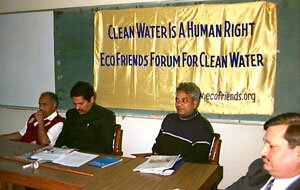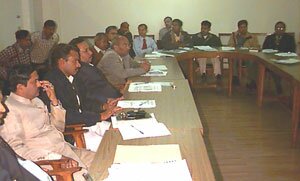
|
2nd Meeting of Consultative Action Group (CAG) on Urban Wastewater use and its impact on livelihoods, health, and environment and ground water pollution problem in Kanpur. Consultative Action Group held its 2 nd meeting on urban wastewater use in IIT Kanpur on January 17, 2005 to discuss about various alternative measures to deal with the problems arising from wastewater in Kanpur . Urban wastewater management has been a source of major concern for the people in the city for a long time. The meeting was attended by eminent academicians, social scientists, engineers, top bureaucrats of different government departments, members from NGOs, and other stakeholders. The organizer of this meeting, Mr. Rakesh K Jaiswal of Eco Friends initiated the discussion by outlining various problems associated with the wastewater generated in Kanpur city. He explained the adverse impacts of wastewater on the livelihoods and local environment at length by citing his own experiences. He criticized the functioning of STPs and ETP at Jajmau, which was set up under Ganga Action Plan (GAP). The plants unleash contaminated wastewater causing severe health hazards, negative impacts on the agriculture and livestock in more than 20 villages located in the eastern most part of the city of Kanpur . As a host of the meeting at IIT Kanpur, Prof. Binayak Rath welcomed all the participants and pointed out the challenges that Participating in the discussion Mr.Sasikant, Chopde, Senior Program Officer, Winrock, New Delhi , suggested that there should be more CAG meetings on wastewater management in order to come up with a sound strategy to deal with benefits and problems associated with wastewater generated in different cities across the country. He also suggested that benefits of wastewater could be tapped and used for irrigation purpose in the water scarce areas after making it contamination free through advance technologies. Dr. Padma S Vankar of FEAT Lab, .IIT Kanpur , highlighted the sufferings and plight of the villagers due to contaminated water released from the nearby treatment plants at Jajmau.
Professor Vinod Tare of IIT Kanpur suggested that the tannery waste should be segregated from sewage water so that the wastewater could directly be used for irrigation purposes. He pointed out that tannery waste carries huge chromium and other toxic contents, which has enormous adverse impacts on health, livelihoods, livestock and agricultural land. If we could keep tannery effluent away from sewage, then 90 % of the problems emerging out of wastewater irrigation would automatically be solved. He also expressed doubt about the functioning of the Chrome Recovery Plants (CRPs) installed by various chrome-tanning units of Kanpur . He opined that the tannery wastewater that is a cocktail of highly toxic chemicals couldn't be treated to safe levels with the existing treatment system and facilities in Kanpur . The Chief Medical Officer representative, Dr. B.Singh assured the panel that he would provide all the logistic assistance to the affected villages. Participating in the deliberations, Mr N S Pandey, Additional Municipal Commissioner of Kanpur City assured that he would furnish all the required information to the members of the CAG for a comprehensive study of the entire gamut of the issue. He also promised to extend full cooperation to the CAG. The GM of Ganga Pollution Control Unit UP Jal Nigam, Mr O P Singhal reported that 88 chrome tanning units had already set up CRP and many more are underway. They also alleged that their department is accorded least priority in the state budget. Sr. Scientific Officer, Department of Environment, Govt. of Delhi, Dr. Anil Kumar , pledged that he would provide all logistic and required assistance within his individual domain for the upcoming workshop on wastewater management in New Delhi . Dr A N Tiwari of Agronomy Department, CSA gave valuable suggestions that the report of the CAG meet with certain recommendations should be sent to various authorities at different levels. He also suggested involving institutions like ICAR, ICMR and NBRI in CAG deliberations. Regional Officer of UPPCB, Mr S R Sachan also was in agreement with Dr Tare that the tannery wastewater should not be mixed with sewage that was being used as irrigation water. He also informed that 23 chrome-tanning units that did not have the CRP had been closed and sealed recently. It was unanimously agreed upon that with a view to mitigate the problems of the farmers down stream of the treatment plants, the tannery wastewater should not be mixed with the domestic wastewater. The efforts should be made to extract chromium and other toxicants from the tannery wastewater and then it may be allowed to flow into the river. All the participants agreed that there should be a National Workshop on the various issues pertaining to the wastewater management in different cities of India . It was also decided that all those who have researched in this subject should be invited to the future meetings to share their research findings and alternative solutions. The CAG meet ended with a vote of thanks by Mr R K Jaiswal. List of participants: " Mr N S Pandey, Additional Municipal Commissioner, Kanpur " Mr O P Singhal, GM, GPCU UPJN " Mr K C Sahu, PM, GPCU UPJN " Mr A K Mittal, GPCU UPJN " Mr S R Sachan, Regional Officer, UPPCB " Mr U C Tiwari, GM, Jal Sansthan " Dr B R Singh, CMO office, Kanpur " Mr K B Varshney, Executive Engineer, KNN " Dr Vinod Tare, IITK " Dr Binayak Rath, IITK " Dr Padma S Vankar, IITK " Mr Pradyot Raja, IITK " Mr N C Sahu, IITK " Mr R N Mahapatra, IITK " Mr Dinesh Bahadur Singh, IITK " Mr Vikas Katiyar, IITK " Dr A N Tiwari, HOD, Department of Agronomy, CSA " Dr R K Trivedi, Director, AITH, Kanpur " Mr Shashikant Chopde, WII, New Delhi " Mr Anil Kumar, Department of Environment, New Delhi " Mr Sonelal Yadav, Pyondi village " Mr Umakant Yadav, Corporator, Ward no. 9 " Dr M A Baig, RIS, New Delhi " Mr R K Jaiswal, Eco Friends " Mr Jeetendra Dixit, Eco Friends " Mr Sanjeev Pal, Eco friends " Mr Rishe Tiwari, Eco Friends " Mr Krishna Murti Sharma, Eco Friends
|
|
|
 the world is facing in terms of urban housing, supply of fresh drinking water, treatment of wastewater, and health hazards due to the degradation of environmental quality. Further, he stressed that there is a need to rehabilitate the lost glories of the Ganges at Kanpur . While describing the glorious history of Kanpur city during the British rule, he quoted a poem written by erstwhile British army officer about the beauty of the city. He expressed serious concerns about the present problems that have plagued the progress of the city and made the life of the citizens more miserable He put forward this as a challenge before the academicians, social scientists, engineers, bureaucrats, NGOs, and other stakeholders to contemplate over these problems and to suggest alternative solutions. He also emphasized on the need of a multidisciplinary approach in the policy making and implementing process. The policy makers should follow a holistic approach in pursuing programs and policies pertaining to the wastewater management in the city.
the world is facing in terms of urban housing, supply of fresh drinking water, treatment of wastewater, and health hazards due to the degradation of environmental quality. Further, he stressed that there is a need to rehabilitate the lost glories of the Ganges at Kanpur . While describing the glorious history of Kanpur city during the British rule, he quoted a poem written by erstwhile British army officer about the beauty of the city. He expressed serious concerns about the present problems that have plagued the progress of the city and made the life of the citizens more miserable He put forward this as a challenge before the academicians, social scientists, engineers, bureaucrats, NGOs, and other stakeholders to contemplate over these problems and to suggest alternative solutions. He also emphasized on the need of a multidisciplinary approach in the policy making and implementing process. The policy makers should follow a holistic approach in pursuing programs and policies pertaining to the wastewater management in the city. From the real stakeholders' side, Sonelal Yadav of Pyondi and Umakant Yadav of Motipur drew attention of the participants while recounting a very sordid story about the suffering of the villagers who are using the wastewater for irrigation. They told how the wastewater irrigation was causing the health hazard, loss of livestock and land fertility. They also pointed out that problems became severe and the livelihoods were at greater risk soon after the installation of treatment plants at Jajmau. U.P Jal Nigam Project Manager, Mr. S.R. Sahu agreed that the magnitude of the pollutants in the wastewater was tremendous and suggested that the adverse impacts could be mitigated if residents of the city became conscious.
From the real stakeholders' side, Sonelal Yadav of Pyondi and Umakant Yadav of Motipur drew attention of the participants while recounting a very sordid story about the suffering of the villagers who are using the wastewater for irrigation. They told how the wastewater irrigation was causing the health hazard, loss of livestock and land fertility. They also pointed out that problems became severe and the livelihoods were at greater risk soon after the installation of treatment plants at Jajmau. U.P Jal Nigam Project Manager, Mr. S.R. Sahu agreed that the magnitude of the pollutants in the wastewater was tremendous and suggested that the adverse impacts could be mitigated if residents of the city became conscious.